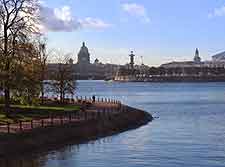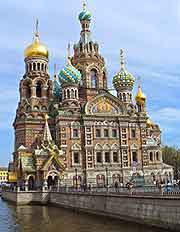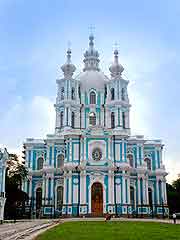St. Petersburg History Facts and Timeline
(St. Petersburg, North-Western Federal District, Russia)

By European standards of history, at just over three centuries old, St. Petersburg is a fairly youthful city. However, although it was officially established in 1703 at the request of Tsar Peter the Great, a Swedish fortress named Nyenschantz was actually built here in 1611, alongside the Neva River. The 18th-century town was to be named after the apostle Saint Peter, being originally spelt as 'Sankt Piter Burkh'.
When the life of St. Petersburg truly began, during the Great Northern War (1700 to 1721), the fortress became known as the Schlotburg and served as a useful point of defence. Today, nothing remains of these once grand fortifications above the ground, although archaeological excavations have revealed evidence of the former bastions. A simple monument was erected to mark this important site at the beginning of the 21st century.
A Maritime History Begins
The location of St. Petersburg was carefully chosen by Peter the Great, who was in need of a reliable and deep commercial seaport near the Baltic coast, since the port at Arkhangelsk was considered to be rather inadequate. He wished to increase trading between other maritime nations and he deemed that this was the place to see this happen. The site was envisaged as a city of shipping, canals and warehouses, as well as being a leading city of architecture.

Peter's Palace and Neoclassical Empire
The magnificent Peter and Paul Fortress (Petropavlovskaia Krepost) was amongst the first buildings to be planned and constructed, and this original citadel remains impressive today, standing on Zayachy Island in the Neva River. The fortress was designed by leading Italian-Swiss architect of the time, Domenico Trezzini, who was also responsible for its centrepiece, the Peter and Paul Cathedral, which was built between the years of 1712 and 1733. Prior to the signing of the Treaty of Nystad in 1721, Peter the Great decided to award St. Petersburg the title of Russian capital in 1712, effectively demoting
Moscow.
Peter the Great chose the neighbouring suburb town of Peterhof to be his summer retreat, since it was a convenient stop-off point for his travels to and from Kronstadt. By 1725, his dream of a waterfront palace was completed, although Peter died in this year. Named Petrodvorets (Peterhof Palace), this extravagant landmark has been further embellished, restyled and expanded by various Tsars over the years.
Completed in 1744, after more than 20 years' worth of construction, the Twelve Collegia is yet another of Domenico Trezzini's 18th-century masterpieces and this red-brick complex comprises 12 buildings, being more than 400 metres / 1,312 feet in length. Of note, the Twelve Collegia is now an integral part of the Saint Petersburg State University. Trezzini and his son also turned their hands to religious buildings, erecting two churches within the grounds of the Saint Alexander Nevsky Monastery in 1722 and 1750.
Construction Problems and Planning
It should be noted that St. Petersburg was known for its harsh weather conditions due to its geographical setting, and so a steady stream of workers and tradesmen were required during this intense period of construction, due to subsequent high rates of mortality. Towards the end of the 1730s, a series of fires caused considerable damage to the city and its boroughs, and Count Burkhard Christoph von Munnich led the way in creating a new St. Petersburg, with five distinct boroughs. The centre was successfully relocated to the borough of Admiralty, between the Neva River and its branch named the Fontanka River.
The Admiralty building immediately formed the centrepiece for the new heart of St. Petersburg, from where the streets of Gorokhovaya, the Nevsky Prospekt and the Voznesensky Prospekt all radiated outwards. During the 1840s, the former Neoclassical architecture style was being influenced by a more 'in vogue' romanticist style, which continued for the rest of the century. This was accompanied by poor suburbs and slums, the emancipation of peasants, and an industrial revolution.

Revolution and War
History shows that the 1905 Russian Revolution began here in St. Petersburg, quickly spreading throughout the adjoining provinces. The city was renamed as Petrograd in 1914.
Further revolutions were to follow, with the February Revolution of 1917 marking an end to the monarchy of Russia. The October Revolution of the same year witnessed the rise to power of communist Vladimir Ilyich Lenin. In 1924, St. Petersburg was renamed once more, changing from Petrograd to Leningrad, and this name remained right up to 1991.
Tourist in the City
Today, the city enjoys a healthy tourism industry, with its extensive transport infrastructure meaning that it is easy to reach the various palaces and icons from the bygone days of St. Petersburg. The centre is now watched over by UNESCO, since it is home to literally thousands of architectural gems, although some were lost forever during the modern development plans of 2005, which resulted in the need for some controversial demolition work.
The cultural heritage and history of St. Petersburg is clearly apparent and the city boasts an incredible selection of museums, which are known to number somewhere in the region of 200. There are also now approximately 80 theatres, more than 100 annual festivals and countless public parks, meaning that you will easily be able to find plenty to fill your days with when you visit.
 By European standards of history, at just over three centuries old, St. Petersburg is a fairly youthful city. However, although it was officially established in 1703 at the request of Tsar Peter the Great, a Swedish fortress named Nyenschantz was actually built here in 1611, alongside the Neva River. The 18th-century town was to be named after the apostle Saint Peter, being originally spelt as 'Sankt Piter Burkh'.
By European standards of history, at just over three centuries old, St. Petersburg is a fairly youthful city. However, although it was officially established in 1703 at the request of Tsar Peter the Great, a Swedish fortress named Nyenschantz was actually built here in 1611, alongside the Neva River. The 18th-century town was to be named after the apostle Saint Peter, being originally spelt as 'Sankt Piter Burkh'.
